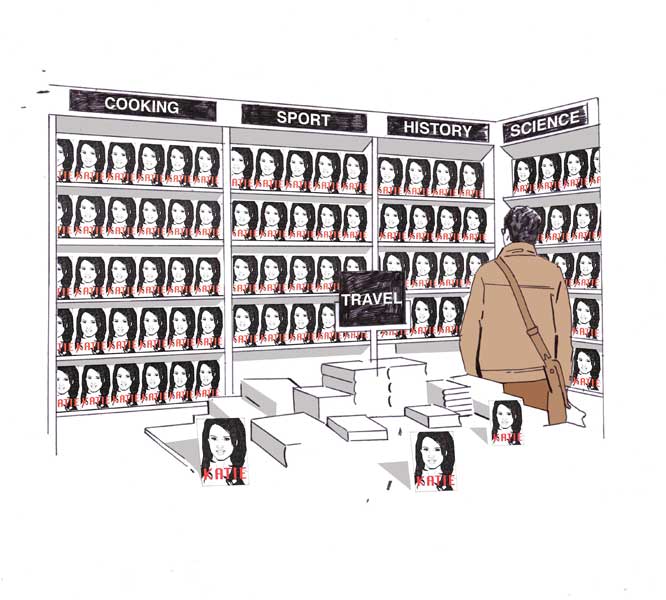2020 vision: Price-erian authors prosper as the latest technology beams bestsellers straight on to the retina

The second decade of the 21st century started in a perilous place for traditional book publishing. Apple launched its Tablet early in 2010, rendering all 2009's e-reader Christmas presents immediately obsolete as users realised that you could download literature on to a wireless device without wanting to bang your head repeatedly against 70 copies of War and Peace. In winter 2010, e-books reigned and so-called Dead Tree Books were burned all over the country in an effort to conserve oil resources. But an unexpected glitch in the technology meant that the Tablet accidentally censored e-copies of Steve Jobs' autobiography, deleting all evidence of the Apple boss's personality from users' blink-proof screens.
Celebrity memoirs otherwise did well, however, when publishers accepted that readers wouldn't buy books any more unless they were written "by Jordan". We already know that Martin Amis was the first to catch on to the trend by basing a character on her in his 2010 novel, State of England. Salman Rushdie soon followed suit, producing a best-selling work of magic realism about two talking bags of silicone who live on a mythical Antipodean island.
Soon, every book published was a classic work of literature fed through a Random Dan Brown Generator and "written" by the 1990s glamour model. Hence the shelves were full of titles such as The Elsinore Paradox by Katie Price, ghostwritten (they add in tiny print) by the likes of Margaret Atwood, Philip Hensher or Irvine Welsh. Naturally, by this stage these were not produced using dead trees, but beamed on to the reader's retina using revolutionary e-lens technology.
Happily, though, fears about the demise of intelligent books coverage on television proved to be unfounded, even after Richard & Judy's and Oprah's book clubs came to an end. The former relaunched in January 2010, as we know, hosted by TV's Gok Wan and Laila Rouass, while the latter is soon to get a revamp with Paris Hilton as its host. Later, ratings zig-zagged as Trinny and Susannah revived The Late Review, and Mark Lawson and Melvyn Bragg moved over to What Not To Wear, broadcast on ITV17 from spring 2013.
The chick-lit craze came to an embarrassing end when a PR company employed to represent the latest pink-clad bonkbuster by an Irish boyband member's wife churned out so much product placement around the launch of the novel that they forgot to produce a novel. Not with ink, e-ink or the revolutionary new Osmosis Inc technology, which allows readers to absorb the content of the latest opus simply by inhaling it. Regular readers will remember that a brief flirtation with calling any novel with a gay character "dick lit" was hastily curtailed following ugly scenes between TV's Gok and Gore Vidal. Sick lit, thick lit and taking the mick lit never really caught on, but for a febrile few years the future looked like belonging to "twit lit", in which the reader could have the constant musings of Stephen Fry injected directly into their bloodstream. There followed a dark period of suspicion and cruel Twitterphobia, as a new computer virus cut swathes through careless users.
Richard Watson's seminal December 2009 classic, Future Files: The Five Trends That Will Shape the Next 50 Years, turned out to be wrong on most counts (disposable phones; a Moon village; nano drinks; smart baths...) but was eerily prescient about the world-shattering invention of sensory internet. Sales of Lady Chatterley's Lover have soared, while Tolkein fans persisted with their by-now somewhat masochistic gadget addictions. The speed of technological progress slowed rapidly at this point because all the geeks were shut indoors rereading the Tiffany Aching scenes from Discworld.
More recently, there was a flurry of excitement when that lost masterpiece by the late literary icon Sebastian Faulks was found in a drawer and cleared for publication by his adoring son. Faulks, it transpires, had begged for the manuscript to be burned after his death because it was evidently a pile of old rubbish. But Penguin rescued it, bound it in covers made of diamonds and sold it with a free snog from Zadie Smith for every reader. It turned out not to fool anyone but inspired a brilliant new publishing trend: novels by real authors, printed on paper and bound with an eye-catching cover design. This maverick idea caught on, as you'll know, when readers discovered that they were cheap, portable and you could read them in the bath. They call it a "book". A publishing sensation has arrived.
Subscribe to Independent Premium to bookmark this article
Want to bookmark your favourite articles and stories to read or reference later? Start your Independent Premium subscription today.

Join our commenting forum
Join thought-provoking conversations, follow other Independent readers and see their replies